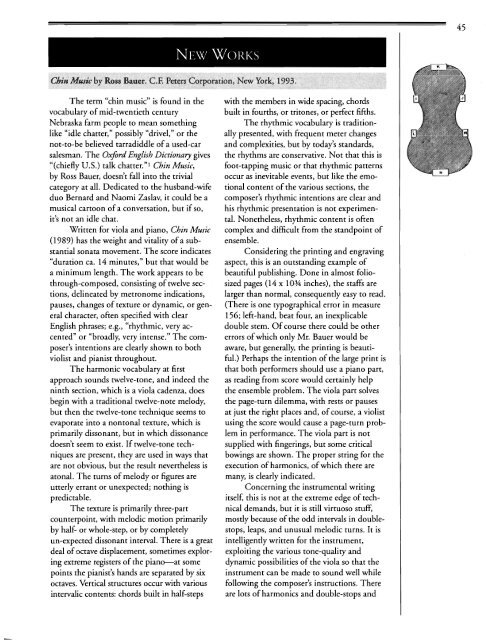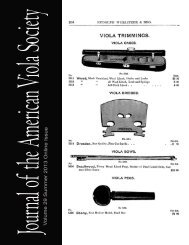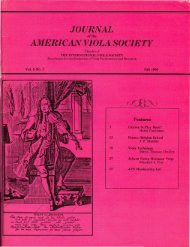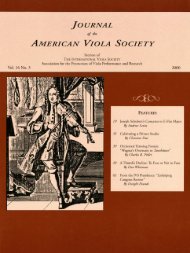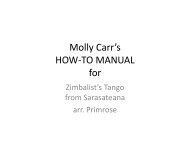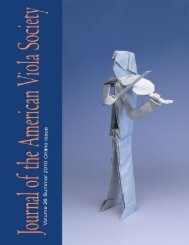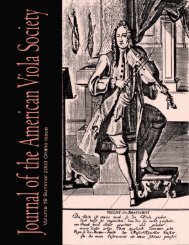Journal of the American Viola Society Volume 10 No. 2, 1994
Journal of the American Viola Society Volume 10 No. 2, 1994
Journal of the American Viola Society Volume 10 No. 2, 1994
You also want an ePaper? Increase the reach of your titles
YUMPU automatically turns print PDFs into web optimized ePapers that Google loves.
NEW WORKS<br />
Chin Music by Ross Bauer. C.F. Peters Corporation, New York, 1993.<br />
The term "chin music" is found in <strong>the</strong><br />
vocabulary <strong>of</strong> mid-twentieth century<br />
Nebraska farm people to mean something<br />
like "idle chatter," possibly "drivel," or <strong>the</strong><br />
not-to-be believed tarradiddle <strong>of</strong> a used-car<br />
salesman. The Oxford English Dictionary gives<br />
"(chiefly U.S.) talk chatter."! Chin Music,<br />
by Ross Bauer, doesn't fall into <strong>the</strong> trivial<br />
category at all. Dedicated to <strong>the</strong> husband-wife<br />
duo Bernard and Naomi Zaslav, it could be a<br />
musical cartoon <strong>of</strong> a conversation, but if so,<br />
it's not an idle chat.<br />
Written for viola and piano, Chin Music<br />
(1989) has <strong>the</strong> weight and vitality <strong>of</strong> a substantial<br />
sonata movement. The score indicates<br />
"duration ca. 14 minutes," but that would be<br />
a minimum length. The work appears to be<br />
through-composed, consisting <strong>of</strong> twelve sections,<br />
delineated by metronome indications,<br />
pauses, changes <strong>of</strong> texture or dynamic, or general<br />
character, <strong>of</strong>ten specified with clear<br />
English phrases; e.g., "rhythmic, very accented"<br />
or "broadly, very intense." The composer's<br />
intentions are clearly shown to both<br />
violist and pianist throughout.<br />
The harmonic vocabulary at first<br />
approach sounds twelve-tone, and indeed <strong>the</strong><br />
ninth section, which is a viola cadenza, does<br />
begin with a traditional twelve-note melody,<br />
but <strong>the</strong>n <strong>the</strong> twelve-tone technique seems to<br />
evaporate into a nontonal texture, which is<br />
primarily dissonant, but in which dissonance<br />
doesn't seem to exist. If twelve-tone techniques<br />
are present, <strong>the</strong>y are used in ways that<br />
are not obvious, but <strong>the</strong> result never<strong>the</strong>less is<br />
atonal. The turns <strong>of</strong> melody or figures are<br />
utterly errant or unexpected; nothing is<br />
predictable.<br />
The texture is primarily three-part<br />
counterpoint, with melodic motion primarily<br />
by half- or whole-step, or by completely<br />
un-expected dissonant interval. There is a great<br />
deal <strong>of</strong> octave displacement, sometimes exploring<br />
extreme registers <strong>of</strong> <strong>the</strong> piano--at some<br />
points <strong>the</strong> pianist's hands are separated by six<br />
octaves. Vertical structures occur with various<br />
intervalic contents: chords built in half-steps<br />
with <strong>the</strong> members in wide spacing, chords<br />
built in fourths, or tritones, or perfect fifths.<br />
The rhythmic vocabulary is traditionally<br />
presented, with frequent meter changes<br />
and complexities, but by today's standards,<br />
<strong>the</strong> rhythms are conservative. <strong>No</strong>t that this is<br />
foot-tapping music or that rhythmic patterns<br />
occur as inevitable events, but like <strong>the</strong> emotional<br />
content <strong>of</strong> <strong>the</strong> various sections, <strong>the</strong><br />
composer's rhythmic intentions are clear and<br />
his rhythmic presentation is not experimental.<br />
<strong>No</strong>ne<strong>the</strong>less, rhythmic content is <strong>of</strong>ten<br />
complex and difficult from <strong>the</strong> standpoint <strong>of</strong><br />
ensemble.<br />
Considering <strong>the</strong> printing and engraving<br />
aspect, this is an outstanding example <strong>of</strong><br />
beautiful publishing. Done in almost foliosized<br />
pages (14 x <strong>10</strong>34 inches), <strong>the</strong> staffs are<br />
larger than normal, consequently easy to read.<br />
(There is one typographical error in measure<br />
156; left-hand, beat four, an inexplicable<br />
double stem. Of course <strong>the</strong>re could be o<strong>the</strong>r<br />
errors <strong>of</strong>which only Mr. Bauer would be<br />
aware, but generally, <strong>the</strong> printing is beautiful.)<br />
Perhaps <strong>the</strong> intention <strong>of</strong> <strong>the</strong> large print is<br />
that both performers should use a piano part,<br />
as reading from score would certainly help<br />
<strong>the</strong> ensemble problem. The viola part solves<br />
<strong>the</strong> page-turn dilemma, with rests or pauses<br />
at just <strong>the</strong> right places and, <strong>of</strong> course, a violist<br />
using <strong>the</strong> score would cause a page-turn problem<br />
in performance. The viola part is not<br />
supplied with fingerings, but some critical<br />
bowings are shown. The proper string for <strong>the</strong><br />
execution <strong>of</strong> harmonics, <strong>of</strong>which <strong>the</strong>re are<br />
many, is clearly indicated.<br />
Concerning <strong>the</strong> instrumental writing<br />
itself, this is not at <strong>the</strong> extreme edge <strong>of</strong> technical<br />
demands, but it is still virtuoso stuff,<br />
mostly because <strong>of</strong> <strong>the</strong> odd intervals in doublestops,<br />
leaps, and unusual melodic turns. It is<br />
intelligently written for <strong>the</strong> instrument,<br />
exploiting <strong>the</strong> various tone-quality and<br />
dynamic possibilities <strong>of</strong> <strong>the</strong> viola so that <strong>the</strong><br />
instrument can be made to sound well while<br />
following <strong>the</strong> composer's instructions. There<br />
are lots <strong>of</strong> harmonics and double-stops and<br />
45


